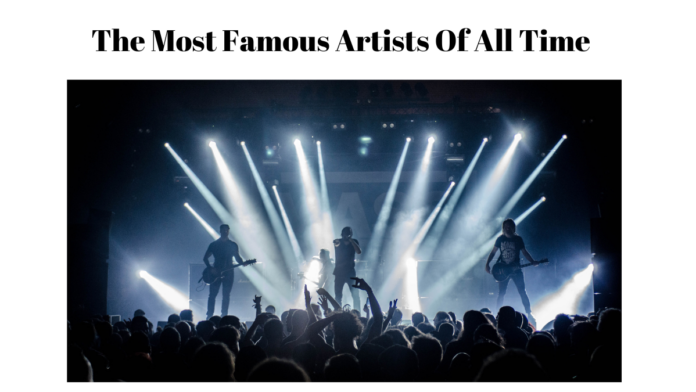To choose the most famous artists is subjective, but some have made a big impact with their art. These artists are known for their timeless pieces, from paintings to sculptures.
You can see their art in New York museums like The Met, MoMA, and the Guggenheim. It is incredible to see art by Da Vinci, Degas, Warhol, Pollak, or Kusama in person.
Here are some of the most famous artists:
Egon Schiele
Egon Schiele (1890–1918) was an Austrian Expressionist painter. His work is characterized by intensity, raw sexuality, and numerous self-portraits, like nude ones. Schiele’s paintings and drawings exhibit twisted body shapes and expressive lines, which makes him as an early exponent of Expressionism. He was mentored by Gustav Klimt and is known for his provocative and emotionally charged art.
He was born in Tulln, Austria-Hungary, Schiele’s early fascination with trains eventually led him to pursue art. His life was marked by controversy, like incestuous tendencies towards his younger sister. Schiele’s legacy lies in his powerful, evocative works that continue to captivate audiences.
Gustav Klimt
Gustav Klimt (1862–1918) was an Austrian symbolist painter and a prominent member of the Vienna Secession movement. His art is characterized by its use of colour and fluid, original draughtsmanship. Klimt’s primary subject was the female body, and his works often blended horror, comedy, and mystery.
His mature style emerged around 1897 when he founded the Vienna Secession a group of painters who rebelled against academic art in favor of a highly decorative style akin to Art Nouveau. His famous works include “The Kiss,” “The Joy of Life,” and “The Woman in Gold.” Klimt’s influence extends to pop art, minimalist art, and conceptual art.
Pablo Picasso
Pablo Picasso (1881–1973) is regarded as one of the most important French painters of the 20th century. He co-created Cubism with Georges Braque and significantly influenced modern art. Picasso’s early works were characterized by intense colorism, and he was a key figure in the Fauvist movement.
His famous pieces include “Les Demoiselles d’Avignon,” “Guernica,” and “The Weeping Woman.” Picasso’s mastery of expressive language through color and drawing solidified his position as a leading figure in modern art.
Henri Matisse
Henri Matisse (1869–1954) was a French artist known for his expressive use of color and original draughtsmanship. He led the Fauvist movement around 1900, which emphasize colour’s expressiveness throughout his career.
His works often featured domestic or figurative subjects with a distinct Mediterranean flair. Matisse’s rigorous style emphasized flattened forms and decorative patterns.
His notable works include “The Dance II” and “The Joy of Life.” Later, he relocated to Nice, where his more relaxed style gained acclaim. His mastery of colour and drawing solidified his status as a modern art figure.
René Magritte
René Magritte (1898–1967) was a Belgian surrealist artist known for his depictions of familiar objects in unexpected contexts. His works often provoke questions about reality and representation. Magritte’s intense colourism between 1900 and 1905 earned him notoriety as one of the Fauves.
His famous pieces include “The Treachery of Images” and “The Son of Man.” His mastery of colour and drawing, which spans over half a century, established him as a leading figure in modern art.
Salvador Dalí
Salvador Dalí (1904–1989) was a Spanish Surrealist painter and printmaker. His work is characterized by intense imagery, raw sexuality, and numerous self-portraits, like nude ones. Dalí’s paintings and drawings exhibit twisted body shapes and expressive lines, marking him as an early exponent of Expressionism.
He was born in Tulln, Austria-Hungary, Schiele’s early fascination with trains eventually led him to pursue art. His life was marked by controversy, like incestuous tendencies towards his younger sister. Schiele’s legacy lies in his powerful, evocative works that continue to captivate audiences.
Georgia O’Keeffe
Georgia O’Keeffe (1887–1986) was an American painter known for her large-format paintings of natural subjects, especially flowers and bones. She also depicted New York City skyscrapers and architectural and landscape forms unique to northern New Mexico. O’Keeffe grew up on a Wisconsin dairy farm and received art lessons at home.
She studied at the Art Institute of Chicago and later in New York City. Her work often explored themes of identity, postcolonialism, gender, class, and race in Mexican society. O’Keeffe’s paintings had strong autobiographical elements and mixed realism with fantasy.
Edward Hopper
Edward Hopper (1882–1967) was an American realist painter known for his realistic depictions of everyday urban scenes. His paintings often evoke existential malaise, which portray quiet, introspective moments of everyday life. Hopper’s technique emphasized light and shadow to evoke mood.
His famous painting “Nighthawks” epitomizes this interest in quiet moments. Hopper’s work influenced the Pop art and New Realist painters of the 1960s and 1970s.
Frida Kahlo
Frida Kahlo (1907–1954) was a Mexican painter known for her self-portraits and works inspired by Mexican culture. She explored questions of identity, postcolonialism, gender, class, and race. Kahlo’s paintings often had strong autobiographical elements and mixed realism with fantasy.
She is considered one of America’s greatest artists and a major figure in the abstract expressionist movement. Her work and example had an enormous influence on subsequent art movements in the United States.
Jackson Pollock
Jackson Pollock (1912–1956) was an American painter and a leading exponent of Abstract Expressionism. He is known for his radical poured, or “drip,” technique, which he used to create his major works.
His paintings, characterized by free-associative gestures, were sometimes called “action painting.” Pollock’s personal commitment to painting influenced many subsequent art movements.
His famous work “Number 17A” epitomizes his interest in abstraction and spontaneity. Struggles with alcoholism marked Pollock’s life, and he died tragically in a car accident. His legacy remains influential in the history of American art.
Andy Warhol (1928–1987)
He was an American artist who became a leading figure in the visual art movement known as Pop Art. His works explore the relationship between artistic expression, celebrity culture, and advertisement that flourished in the 1960s.
Warhol’s art used many types of media, like hand drawing, painting, printmaking, photography, silk screening, sculpture, film, and music.
Warhol was born Andrew Warhola in Pittsburgh, Pennsylvania. Before he became a renowned artist, he was a successful commercial illustrator. His New York studio, The Factory, became a famous hotspot for artists, intellectuals, celebrities, and other bohemians.
Warhol’s work is notable for exploring the concept of celebrity and brand culture, as seen in his iconic works like Campbell’s Soup Cans and portraits of Marilyn Monroe. He also managed and produced the rock band The Velvet Underground and founded Interview magazine.
Yayoi Kusama (born 1929)
He is a Japanese contemporary artist who works in a number of media, like painting, sculpture, performance art, and installations. Kusama is known for her extensive use of polka dots and her infinity installations.
She has been acknowledged as one of the most important living artists to come out of Japan and is recognized as the world’s top-selling female artist.
Kusama was born in Matsumoto, Nagano, Japan, and began painting as a child, inspired by her hallucinations of fields of dots. These hallucinations and the theme of dots have continued to inform her art throughout her career. She moved to New York City in 1958 and became a part of the avant-garde scene, especially in the Pop Art movement.
Kusama’s work is infused with autobiographical, psychological, and sexual content, and she has been open about her mental health, stating that art has become her way to express her mental problems.
Leonardo da Vinci
He (1452–1519) was the quintessential Renaissance man, a master of both art and science. He painted the iconic Mona Lisa and The Last Supper, works that exemplify his skill in capturing human expression and emotion.
Leonardo’s curiosity extended beyond art; he sketched designs for various machines, like aircraft and tanks, which shows his visionary mind.
Michelangelo (1475–1564)
He is a one of the best famous artists figure of the Renaissance and excelled as a painter, sculptor, and architect. His frescoes on the Sistine Chapel’s ceiling and his sculptures of David and Pieta are considered some of the greatest artworks ever created. Michelangelo’s work for the Medici Popes in Rome solidified his legacy as a master artist.
Rembrandt (1606–1669)
The Dutch master is renowned for his deep psychological insight into his subjects, as seen in The Night Watch and Doctor Nicolaes Tulp’s Demonstration of the Anatomy of the Arm. His portraits and self-portraits reveal a profound understanding of human nature.
Johannes Vermeer (1632–1675)
After being forgotten for centuries, he is now celebrated for his serene and luminous paintings like Girl with a Pearl Earring. Some speculate that Vermeer used a camera obscura to achieve his distinctive depiction of light.
Jean-Antoine Watteau (1684–1721)
He shortens the transition from Baroque to Rococo art. His works, characterized by their colour and movement, influenced later artists such as Turner and the Impressionists. Watteau is best known for his fêtes galantes, scenes of bucolic charm infused with a theatrical air.
Eugène Delacroix (1798–1863)
He is a central figure in Romanticism, was known for his expressive brushwork and bold use of color. His dramatic and romantic content had a significant impact on the development of modern art, influencing movements like Impressionism and Post-Impressionism.
Claude Monet (1840–1926)
He is the father of Impressionism, capturing the transient effects of light on landscapes. His series paintings, such as the Water Lilies and Haystacks, are celebrated for their representation of light and atmosphere.
Georges Seurat (1859–1891)
He the founder of Neo-Impressionism, developed the technique of pointillism. His methodical use of color and structured compositions marked a departure from traditional Impressionist techniques.
Vincent van Gogh (1853–1890)
Although his life was marked by mental illness, he created some of the most influential works in Western art. His bold colours and dramatic brushwork, seen in paintings like The Starry Night, contributed to the rise of Expressionism.
Edvard Munch (1863–1944)
He is a Norwegian painter, is best known for The Scream, an image that encapsulates modern existential angst. His treatment of psychological themes laid the groundwork for German Expressionism and had a lasting impact on 20th-century art.
FAQs
Who are some of the most famous artists?
Some of the most famous painters include Leonardo da Vinci, known for the Mona Lisa; Vincent van Gogh, famous for The Starry Night; and Pablo Picasso, known for Guernica.
What is Michelangelo known for in sculpture?
Michelangelo is renowned for his sculptures like the David and the Pieta, which are masterpieces of Renaissance art.
Can you name some of the famous artists?
Yes, Georgia O’Keeffe is well-known for her large-scale paintings of flowers and landscapes, and Frida Kahlo is celebrated for her deeply personal self-portraits.
Read More:
- Lawmen: Bass Reeves – How many children did Bass have? Explained
- Kat Timpf Net Worth and Biography: A Deep Dive into Her Life and Success
- Horacio Pagani Net Worth in 2024: A Closer Look at the Visionary Automaker’s Fortune
- Justin Waller: Transforming Challenges into Opportunities
- Julie Lauren Curtis: A Journey Through Struggles and Strength















